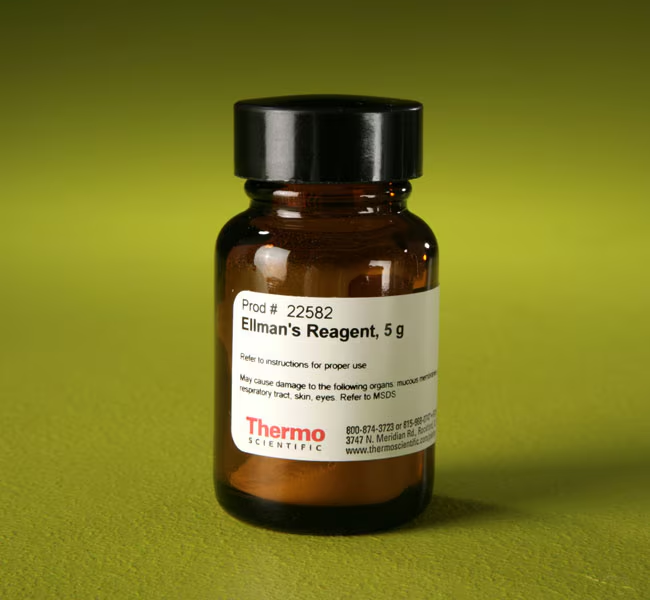
Thermo Scientific Pierce Ellman's Reagent (DTNB) reacts with sulfhydryl groups to yield a colored product, providing a reliable method to measure reduced cysteines and other free sulfhydryls in solution.
Ellman's Reagent (5,5'-dithio-bis-[2-nitrobenzoic acid]) is used to estimate sulfhydryl groups in a sample by comparing to a standard curve of a sulfhydryl-containing compound such as cysteine. Alternatively, sulfhydryl groups can be assayed using the extinction coefficient of TNB (14,150M-1 cm-1 at 412nm). Ellman's Reagent has been used for applications other than sulfhydryl estimation, such as for determining alkylthiols by HPLC using a pre-column derivatization procedure and to study thiols in the active site of several enzymes.
Features of Ellman's Reagent:
• Sulfhydryl assay—reacts quantitatively with free (reduced) sulfhydryl groups (—SH) to yield detectable TNB product
• Colorimetric detection—colored product enables spectrophotometric measurement in cuvettes or microplates (λmax = 412nm; ε = 14,150/M·cm)
• Proven method—well-characterized chemistry provides quantitation of peptide or protein sulfhydryl groups using extinction coefficient calculation or by comparison to a cysteine standard
Reagent Properties
• Alternative names: DTNB, Ellman's Reagent
• Chemical name: 5,5'-dithio-bis-(2-nitrobenzoic acid)
• Reactive toward: Sulfhydryl groups (—SH)
• Chemical formula: C14H8N2O8S2
• CAS number: 69-78-3
• Molecular weight: 396.35
• Form: Yellow crystalline powder
DTNB reacts with a free sulfhydryl group to yield a mixed disulfide and 2-nitro-5-thiobenzoic acid (TNB). The target of DTNB in this reaction is the conjugate base (R—S-) of a free sulfhydryl group. Therefore, the rate of this reaction is dependent on several factors: (1) the reaction pH, (2) the pKa' of the sulfhydryl and (3) steric and electrostatic effects. TNB is the colored species produced in this reaction and has a high molar extinction coefficient in the visible range. The molar extinction coefficient of TNB was originally reported by Ellman (1959) to be 13,600M-1 cm-1 at 412 nm and pH 8.0. Consequently, this value has been cited frequently in the literature. Later studies have shown, however, that the molar extinction coefficient is more accurately reflected by a value of 14,150M-1 cm-1 at 412 nm. The extinction of TNB is not affected by changes in pH between 7.6 and 8.6. However, the extinction of TNB is different in other solvents.
| Code | Description |
|---|---|
| 22582 | Catalog Number: 22582 |

